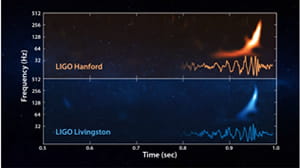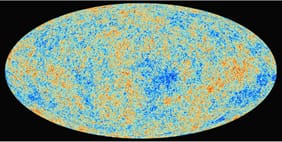Measuring the Universe with Optics
Measuring the Universe with Optics
Rebecca B. Andersen
OSA’s Centennial Light the Future speaker series traveled to China to the Asia Communications and Photonics Conference (ACP) in Wuhan on 3 November 2016. Nobel Laureate, former U.S. Secretary of Energy and a fellow of The Optical Society, Dr. Steven Chu explained the history of gravitational discoveries and how they have been enabled by advancements in optics.
Bending Light
Einstein prescribed that if there is no action at a distance, the gravitational field change has to propagate as a wave. Einstein later went onto develop the Equivalence Principle which proved that light must bend. Chu asked in his presentation – what is light? Light is the shortest distance between two straight lines. That alone meant that space has to bend.
The very geometry of space and time are curved due to gravitational mass. This curve was heard on 14 September 2015 at 5:51 a.m. EST, when a very specific set of 40 kg mirrors moved in a very specific way — a distance thousands of times smaller than a proton — and scientific discovery entered a new era.
LIGO - The Big Change in Gravitational Fields; Enhanced by Big Optics
With a 24:1 signal to noise ratio, the most stable optical system ever built measured a gravitational wave's low frequency effect through distance changes of about 10-18 m, or about 1/1,000 the diameter of a proton.

Chirp pattern of gravitational waves detected by LIGO on 14 September 2015. Credit: LIGO http://www.ligo.org/

Image credit: ESA and the Planck Collaboration
The many discoveries and cutting edge developments over the last 40 years have led to a gravitational wave observatory operating just in time to pick up the after-effects of two black holes merging into one, 1.3 billion light years away. The sub-nuclear sized motions of LIGO’s mirrors brought an end to this decades-long quest for that first signal, and a beginning to a new era of measuring the evolution of the universe. What resulted is a laser interferometer, the next version of the Michelson Interferometer — the most precise measurement tool that we have today.
Stretching the Rulers of Space and Time
After neutral atoms formed, light was no longer strongly coupled to matter. The decoupled light works to provide a snapshot of the Universe 380,000 years old (in our 13.7 billion year life). Subtract out the anomalies in the 3° microwave background radiation measured by the Plank mission. Never before witnessed was the most accurate and detailed map made of the oldest light in the universe, revealing new information about its age, contents and origins. With this, Chu stated “As the universe is changing, the rulers of space and time are changing. The rulers in space and time are stretching and so the light stretches, going from the high energies to the infrared and microwave spectrum.”
Optical discoveries in the mid-1980’s lead research teams around the world to focus on cooling atoms through the use of light (or photons). For what went onto earn him a share of the 1997 Nobel Prize in Physics, Chu developed the first atomic trap that held the chilled atoms in place, instead of letting them fall under the influence of gravity. From there, Arthur Ashkin discovered optical tweezers in 1986 and in 1987 the process of magneto-optical trapping. In seven years, this trapping technique went onto become the frequency standard of the world.
The Value of an Accurate Atomic Optical Clock
Once scientists learned how to cool atoms, great progress was made with the development of optical clocks. GPS-based navigation, communication systems, electrical power grids and financial networks all rely on the precise time kept by a network of around 500 atomic clocks located around the world. A more accurate global time keeping system allows for financial networks to use more precise time stamps and thus accurately handle even more transactions in shorter amounts of time. Optical clocks also enable GPS and other satellite-based navigation systems to provide even more precise location information for the navigation of ships, airplanes, cars and tractors, and these devices also enable the ability to provide notice of the movement of tectonic plates and the capability to monitor global warming.
Today’s Measurement Tools will Impact our Time on Earth
NASA’s GRACE mission, with twin satellites launched in March 2002, continues today to make detailed measurements of the Earth's gravity field which will lead to discoveries about gravity field anomalies and Earth's natural systems, such as climate, oceans and geology. Chu believes these discoveries could have far-reaching benefits to mitigating the risks of climate change and enhancing current developments in solar energy.
Chu believes that all of those solutions and cutting edge developments will lead us into a new era of measuring the universe with optics.
Click an image to view larger.
